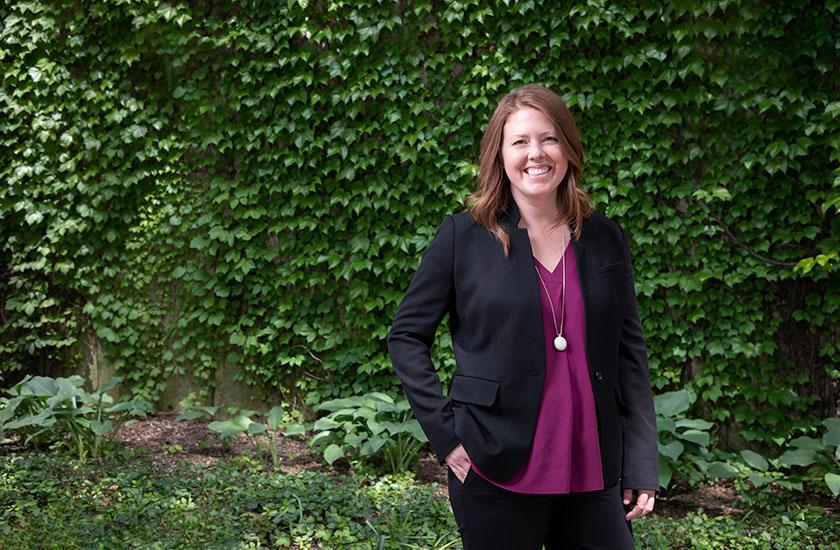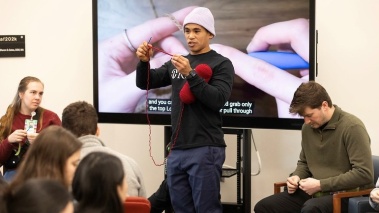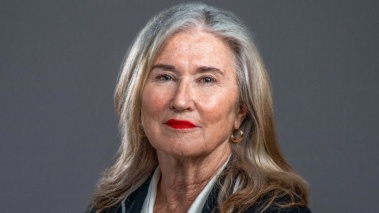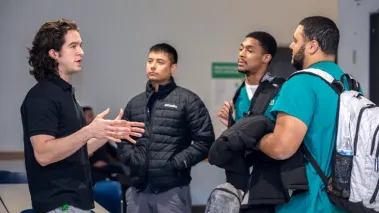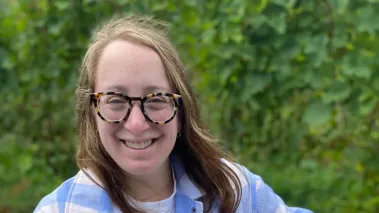When Lauren Little, PhD, develops programs to help children on the autism spectrum reach their potential, considering the circumstances of the child’s family is at the core of her approach. Little, an assistant professor of occupational therapy at Rush University’s College of Health Sciences, takes into account what efforts their families will be able to sustain in the face of the other stressors and obligations they already have, such as jobs and other children. She always asks, "What are some ways parents can feel successful with strategies that are compatible with their daily life?"
Autism spectrum disorder, or ASD, is a neurodevelopmental condition characterized by social interaction and communication difficulties, as well as the restricted or repetitive patterns of thought or behavior. ASD appears early in childhood and affects an estimated one in 59 American children. To varying degrees, people with ASD have difficulties with social skills, speech and nonverbal communication; exhibit repetitive behaviors and developmental lags; and may be susceptible to spikes of anxiety and other emotions.
Some people with ASD may require lifelong support. With early behavioral support and therapy, however, people with autism can succeed in many areas of life.
As a researcher, Little helps design and test ways to support families of young children with ASD ranging from 2 to 8 years old. She’s looking for ways to assist those children with some of the most basic functions of life, such as eating and toileting.
"Potty training is a huge need,” Little says. “Parents of children with autism really need support with it."
Research on how long the process should take is scarce, she says, but studies that have been done suggest children with autism can take three times as long to complete the transition out of diapers than those with a typical development trajectory. Little is now conducting a study in which her team provides support to parents who are currently toilet training their children with autism, as these children need specific types of help to learn to independently use the bathroom. This milestone is crucial for parents and child alike, since children can’t join certain after-school activities or camps unless they are toilet trained.
Building family resilience
Different types of therapies, such as occupational or speech therapy, can be time- and effort-intensive for families. One aspect of Little's research looks at ways to meet families' developmental goals for their children without exhausting their resources. Different levels of treatment for very young children are available and costs vary. Insurance coverage for these treatments is also a factor. Little encourages families to set reasonable objectives they can live with and to re-evaluate them as they go.
The basic method Little investigates is "occupation-based coaching." Little calls it "a way for an occupational therapist to interact with families so those families can gain insight into their own situations and come up with their own plans for addressing whatever difficulties they're experiencing. We're interested in building family resilience. The best thing I can do is make it so parents don't need me — at least for a while — and they can come up with strategies that work for them in their everyday lives."
With this method, if a child has trouble functioning on a family outing — or on the other hand, sails through the event calmly — the parent learns to assess what has happened in those situations. "Sometimes the environment can really facilitate excellent participation, but sometimes it can hinder it," Little says. By encouraging parents to think about how the environment influences their children’s behavior, parents can be successful in helping their children through different experiences outside of the home.
Little’s research has used telehealth, or videoconferencing, to support parents. In one study, Little's team communicated with parents about how to problem-solve when trying to encourage children to eat a range of foods. The team coached parents to solve problems on their own and to be mindful of what might be influencing the child's behavior. For example, why does he eat the turkey sausage samples at the grocery store when he'd never touch that food at home?
"Does he like the little white cup the sample comes in at the store? Or does he need a more relaxed environment — one where the attention isn't on 'Eat, eat, eat!'?" Little says. Parents learn to ask those questions themselves.
Telehealth shows promise
Little is also investigating the relatively new use of telehealth technology — occupational therapists working remotely but interactively, online or by video chatting — which has real promise for children with autism, especially those who are underserved (i.e., living in areas where few OT providers are available). Telehealth cuts down on travel and can be significantly less expensive than face-to-face therapy. However, insurance doesn't pay for occupational therapy delivered over telehealth yet. Little hopes her research will not only provide evidence of the efficacy of telehealth but also will identify and address policy issues that could pave the way to insurance coverage.
Embracing occupational therapy as a new occupation
Little grew up in Chicago, received her undergraduate degree from DePaul University and then taught preschool for a while. A few children in her classes at the time were being helped by occupational therapy, and she eventually decided it was the work she wanted to do as well.
"Occupational therapy supports kids to fully participate with their peers and their families. That's what drew me to the profession,” Little says. “It's so important that all children are fully involved in the classroom and in the community instead of sitting on the sidelines."
She received a master’s degree in occupational therapy from the University of Illinois at Chicago and went on to earn a PhD in occupational science from the University of North Carolina at Chapel Hill, where she specialized in early identification and treatment for children with autism, and completed a postdoctoral fellowship there.
Little taught at the University of Kansas campus in Kansas City, Kansas, where she also conducted research with Winifred Winnie Dunn, PhD, a neuroscientist and pioneer in assessing children's sensory processing abilities. Little's research included studies of sensory processing in children with ASD, with a focus on adaptive behavior, such as eating behaviors and toileting. After four years in Kansas, she came back to Chicago to be closer to her family, and joined Rush.
A perfect fit
It was a perfect fit for her because Rush is clinically focused and was one of the first schools in Chicago to require an entry-level clinical doctorate into the occupational therapy field. "I wanted to be part of that department," she says.
Moving from Kansas to Chicago opened her eyes to the fact that rural areas are not the only places where children who need occupational therapy services may be underserved. In a city, transportation can be a hurdle, since not everyone drives or is even close to a helpful bus or train route, and the cost of therapy can be prohibitive — including the cost of a parent taking time away from work to get the child to a clinic.
Little's research is geared to making it easier for families to access services. She advises parents who wonder if their child might have a form of autism to consult with a specialist right away. "All of the behavioral research supports that the earlier intervention begins, the better for the child," she says.

